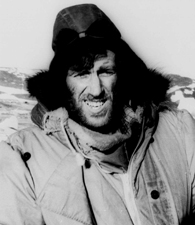An explorer at heart, humble New Zealand beekeeper Edmund Hillary became the first man to reach the peak of Mount Everest in 1953, and later traveled to both the South and North Poles. He was also well known for his charity work and long-lasting fondness of the people of Nepal.
Edmund Hillary’s Early Days
Edmund Percival Hillary was born on July 20, 1919, in Auckland, New Zealand. He was intrigued by adventure at an early age, exploring the local wilderness and reading many adventure stories. At age 16, he went mountain climbing for the first time while on a class trip to Mount Ruapehu; four years later, he reached his first peak, Mount Ollivier in New Zealand’s Southern Alps.
Hillary attended university for two years, but dropped out to follow his father into the beekeeping business. At the outbreak of World War II, he initially decided against serving in the military due to his family’s pacifist religious beliefs, but entered the air force later in the war. He served as a navigator, but his service came to an end in 1945 when he was badly burned in a boating accident.
Sources in this Story
- New Zealand Ministry for Culture and Heritage: New Zealand History: On top of the world: Ed Hillary
- Royal Geographical Society: Imaging Everest: Mount Everest Expedition 1953
- Academy of Achievement: Sir Edmund Hillary
- New York Times: Edmund Hillary, First on Everest, Dies at 88
The Daily Telegraph: Sir Edmund Hillary: ‘hellbent for the Pole’
NPR: Climber Edmund Hillary, Everest Pioneer, Dies at 88
National Geographic: Sir Edmund Hillary, Everest Pioneer, Dies at 88
Hillary’s Notable Accomplishments
After recovering from his injuries, Hillary dedicated his life to climbing, ascending mountains in New Zealand, the European Alps, and the Himalayas. In 1951, he took part of a British reconnaissance expedition up Mount Everest. Two years later, he joined a British expedition that hoped to reach Everest’s peak.
Hillary was one of 14 Western climbers in the expedition, which also included 35 Nepalese Sherpas and hundreds of porters. The expedition leader, Colonel John Hunt, selected two two-man assault teams who would attempt to reach the peak; Hillary was selected for the second team along with Sherpa Tenzing Norgay, who had also taken part in the 1951 expedition.
After two weeks of climbing, the expedition reached a point more than 25,000 feet high. After the first assault team failed to reach the peak, Hillary and Norgay were sent. The two endured a treacherous climb, which included a night spent at 27,900 feet and the scaling of a 40-foot ice face now known as Hillary Step, but they were able to reach the peak on the morning of May 29.
Hillary described: “I continued hacking steps along the ridge and then up a few more to the right … to my great delight I realized we were on top of Mount Everest and that the whole world spread out below us.”
The two spent just 15 minutes at the peak before descending back to the rest of the team. When Hillary was asked about their climb, he replied, “Well, we knocked the bastard off.”
Hillary became an international celebrity and a hero in New Zealand and Britain, where news of his success coincided with the coronation of Queen Elizabeth II. The queen knighted Hillary just weeks after his climb.
And yet Hillary remained modest. Robert McFadden, a writer for The New York Times described Hillary as having “tigerish confidence on a mountain but little taste for formal social doings.” McFadden added, “For many years after the Everest climb, he continued to list his occupation as beekeeper.”
Hillary then set his sights on polar exploration. In 1958, he took part in an expedition to the South Pole led by British explorer Vivian Fochs. Leading a New Zealand party that was traveling ahead of Fuchs and leaving supplies, Hillary was supposed to wait for Fuchs at a depot near the pole. However, as Fuchs lagged behind schedule and communication broke down, Hillary decided to travel ahead, “hellbent for the South Pole—God willing and crevasses permitting.”
Hillary reached the pole on January 4, 1958, completing the first overland expedition since Roald Amundsen in 1911 and the Robert Falcon Scott in 1912. He decision to press on without Fuchs caused a controversy, as some accused him of trying to steal Fuchs’ glory.
In 1985, he was flown to the North Pole with Neil Armstrong, making him the first man to stand on both the North and South Poles, as well as the highest point in the world.
The Rest of the Story
Hillary maintained a fondness for the Nepalese people long after his climb up Mount Everest. He founded the Himalayan Trust, which built schools, clinics and hospitals around Mount Everest. In the 1980s, he also acted as either ambassador or high commissioner to India, Bangladesh, and Nepal.
Decades passed before Hillary ever admitted whether he or Norgay stepped on Everest’s peak first, insisting that the two reached the top as a team. In 1999, Hillary revealed the truth in his autobiography. “We drew closer together as Tenzing brought in the slack on the rope. I continued cutting a line of steps upwards. Next moment I had moved onto a flattish exposed area of snow with nothing but space in every direction.”
Hillary died on January 11, 2008, of heart failure at the age of 88.











